The world under the ocean has always fascinated us, and more so, children. Aquatic animal facts help your kiddo learn a lot about the animals that live underwater.
Types of Aquatic Animals
Did you know that these animals can be classified on the basis of their appearance and behaviour? Keep reading to know more!
1. Molluscs
Molluscs are a group of invertebrate aquatic animals, i.e., they don’t have a backbone. Squids, octopuses, cuttlefish, snails, slugs, clams, scallops, etc. are, in fact, molluscs. They use their radula to scrape off and eat tiny plants and animals. Octopuses and cuttlefish can camouflage themselves and give their prey a nasty surprise!
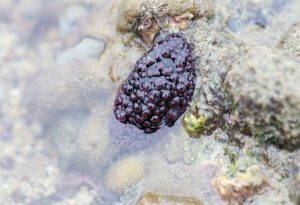
2. Crustaceans
Crustaceans are a group of aquatic animals that have a hard shell. This group includes shrimps, crabs, lobsters, prawns, barnacles, and crayfish. Many crustaceans are scavengers and feed on dead creatures in the ocean. However, some lobsters and crabs are active predators and seize prey with their claws.
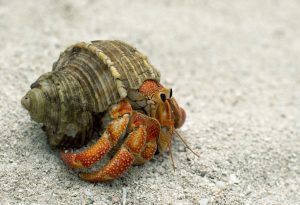
3. Whales
Whales are the largest animals on earth. They are mammals and produce milk from their mammary glands. Whales feed on plankton, fish, krill, crabs, etc. Orcas, also called killer whales, eat sea lions, sharks, seals and even other whales!
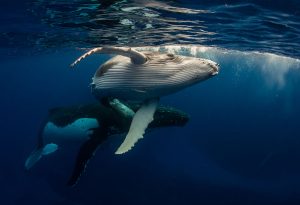
4. Dolphins
Dolphins are highly intelligent aquatic mammals that belong to the toothed whale family. They eat squid, fish and seals. Dolphins are very social and live in groups called ‘pods’. The pods comprise of dozens or hundreds of dolphins. Humans have seen them helping injured members of their pod, protecting swimmers from sharks, and even guiding stranded whales out of shallow water!
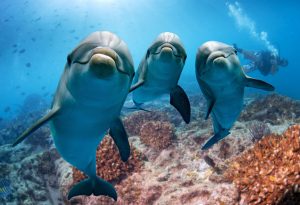
5. Walruses
Walruses are large, brown-coloured marine mammals that have flippers and tusks. They live in the Arctic Ocean and the sub-arctic seas. Their food is mussels, clams and other sea creatures. Walruses use their tusks to break through the ice and also defend themselves.

6. Sharks
Sharks are marine predators. They have multiple rows of very sharp teeth and a skeleton made of cartilage. They breathe underwater through gills. Sharks eat fish, molluscs, crustaceans, krill, and even smaller sharks. Did you know that these animals have a very strong sense of smell, and can smell blood even when they’re miles away?

7. Stingrays
Stingrays are related to sharks. They have flat bodies with large, wing-like fins that they flap up and down to swim. Stingrays have thin tails that contain venom. When threatened, these animals sting with their tail – that’s why they’re called stingrays!

8. Corals
Corals are marine animals that live in colonies called polyps. These creatures attach themselves to one another. Each polyp has a mouth that is surrounded by tentacles. The tentacles are important to corals for three reasons – they offer protection, can capture small animals and also clear the debris away.

9. Alligators
Alligators are reptiles native to America and China. They are freshwater animals, living in lakes, swamps, ponds, and rivers. They have broad snouts and are black. Alligators have tough armour-plated skin. They are carnivores, feeding on deer, birds, small mammals, fish, crustaceans and other reptiles.
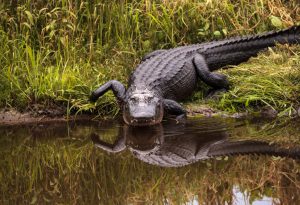
10. Crocodiles
Crocodiles are closely related to alligators. They are found in Asia, Africa, Australia and America. These animals have long, narrow snouts. They can live both in fresh- and saltwater. Amphibians, birds, mammals, crustaceans, are their food. Sometimes, they eat humans, too!
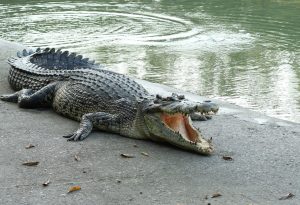
11. Turtles
Turtles are aquatic reptiles that have a hard, bony shell which shields their body. They live in water most of their life. Freshwater turtles live in lakes and ponds. Sea turtles live in the ocean and come out to lay eggs on the sandy beach. They are omnivores that feed on plants, fish, insects, molluscs, frogs, grasses, and algae.
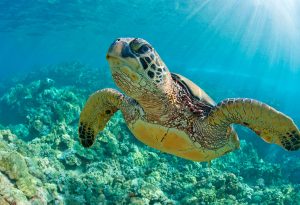
12. Seahorses
The head and neck of seahorses are similar to that of a horse. They also have a long snout and a curled tail that can grasp objects. They feed on larval fish and tiny crustaceans. As these aquatic animals lack a stomach, they consume their food slowly.

13. Salmon
Salmon is a type of fish that is born in freshwater, migrates to the ocean and returns to freshwater to reproduce. They are consumed by humans for their high protein content, vitamin D and omega-3 fatty acids.
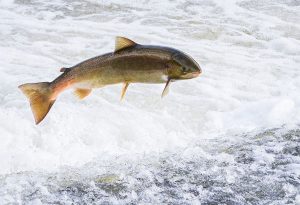
14. Jellyfish
Jellyfish are transparent, jelly-like marine animals. They have bell-shaped bodies with an umbrella-shaped head and several tentacles. These fish are either colourless or have bright colours like pink, blue and purple. Most types of jellyfish are luminescent – they emit light from their bodies. They have hundreds of venomous, sting cells in their tentacles.
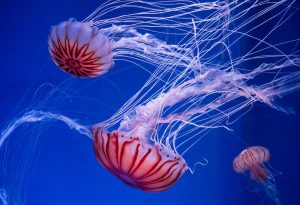
15. Eels
Eels are elongated fish that have a snake-like body. Their fins are fused to form one long ribbon running along the length of their bodies. They live in shallow waters of the oceans, in holes known as eel pits. Eels are widely used in Korean cuisine.

Facts About Aquatic Animals for Kids
Here are some more interesting facts:
- The blood of eels is toxic to human life. However, cooking destroys the toxins and makes them edible.
- Parenting roles are reversed in seahorses. The male seahorse carries eggs in a pouch on his abdomen until they hatch.
- The largest blue whale recorded was 110 feet long. The heart of a blue whale weighs as much as a car, and its tongue weighs as much as an elephant!
- The giant Arctic jellyfish has tentacles that are over 36 metres long.
- Hermit crabs make their homes in the discarded shells of other crustaceans.
- Jellyfish existed even before the dinosaurs; they have been around for over 650 million years.
- An electric eel can produce an electric shock strong enough to knock down a horse.
- Octopuses have blue blood.
- Turtles inhabit every continent except Antarctica.
- Starfish and oysters can change their gender.
- Dolphins sleep with one eye open.
- A sea sponge doesn’t have a head, eyes, mouth, heart or brain.
- The smallest seahorse is as big as a postage stamp.
- Starfish have an eye at the end of their arms. They can also regrow their arms if they get cut off.
- When an octopus is threatened, it shoots out a cloud of dark ink.
- Sea otters wrap themselves in seaweed to prevent themselves from drifting away into the ocean.
- Dolphins and whales cannot breathe underwater due to the lack of gills.
- Crocodiles remove excess salt from their bodies through their eyes.
- The box jellyfish is a venomous creature. Its venom can kill 50 people at once!
- Giant squids’ eyes are the size of basketballs.
Bookmark this article so that you can revisit whenever you wish to! If your child shows an interest in nature and animals, he is ‘Nature Smart’. To enhance this ‘Smart’ as well as identify your little one’s other interests, introduce him to activity boxes designed for kids. Let him master his skills through fun activities!









